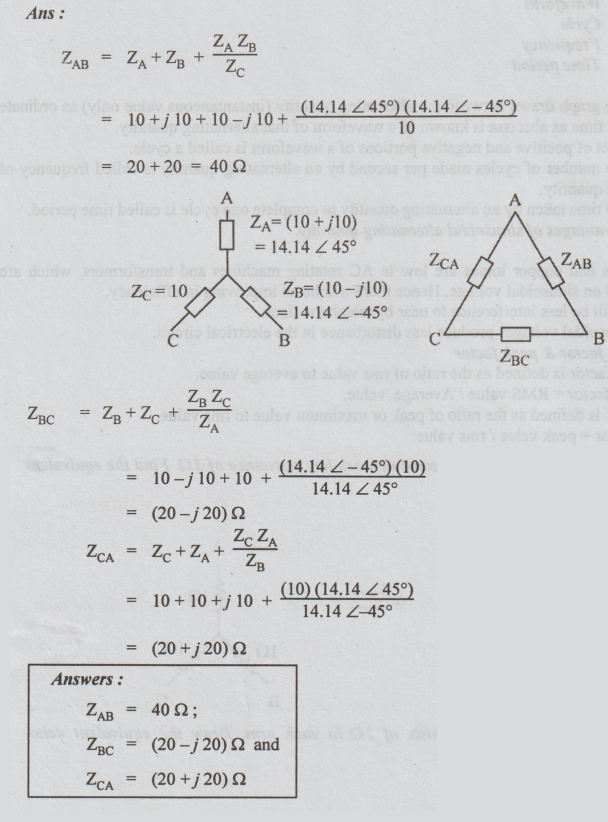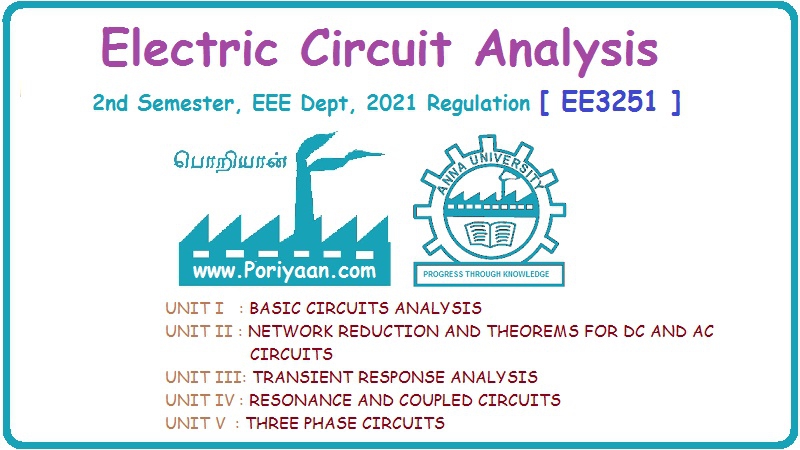Electric Circuit Analysis: Two Mark Question and Answers
Two Mark Question and Answers set - 2
Electric Circuit Analysis
Electric Circuit Analysis: Two Mark Question and Answers
26.
Three impedances (10+ j10) 2, (10-j10) 2 and 1022 are in star. Find the values
of the impedances in the equivalent delta.
Ans
:

27.
Define R.M.S. value.
Ans:
The steady current which when flows through a given resistor for a given time
produces the same amount of heat as is produced by the alternating current when
flows through the same resistor for the same time is called R.M.S. or effective
value of the alternating current.
28.
Define average value.
Ans:
The average value of a given alternating quantity is defined as the D.C.
current which transfers across any circuit the same charge as is transferred by
that alternating current during the same time.
29.
Define the following terms
a.
Waveform
b.
Cycle
c.
Frequency
d.
Time period
Ans
:
a.
The graph drawn between the alternating quantity (instantaneous value only) as
ordinate and time as abscissa is known as a waveform of that alternating
quantity.
b.
A set of positive and negative portions of a waveform is called a cycle.
c.
The number of cycles made per second by an alternating quantity is called
frequency of that quantity.
d.
The time taken by an alternating quantity to complete one cycle is called time
period.
30.
State the advantages of sinusoidal alternating quantity.
Ans
:
i.
Iron loss and copper losses are low in AC rotating machines and transformers,
which are operated on sinusoidal voltage. Hence there will be an improving in
efficiency.
ii.
There will be less interference to near by telephone lines.
iii.
The sinusoidal voltages produce less disturbance in the electrical circuit.
31.
Define form factor & peak factor
Ans:
Form
factor is defined as the ratio of rms value to average value.
Form
factor = RMS value / Average value.
Peak
factor is defined as the ratio of peak or maximum value to rms value.
Peak
factor = peak value / rms value.
32.
State the importance of form factor & peak factor.
Ans:
They give the indication of the shape of waveform.
If
the form factor and peak factor are of high value, then the peak of the wave is
more pointed.
33.
What is a phasor?
Ans:
It is a rotating vector.
34.
For the purely resistive circuit excited by sinusoidal varying voltage, what
are the phase angle and p.f?
Ans:
Both voltage and current are in phase i.e. the phase angle is 0 deg and hence
the p.f. is 1 (UPF).
35.
For the purely inductive circuit supplied by sinusoidal varying voltage, what
is the phase relation between current and applied voltage. How are applied
voltage and induced emf?
Ans:
The current lags behind the applied voltage by II/2 radians.
The
applied voltage and induced emf are in anti phase (according to Lenz's law).
36.
In above question, what are the phase angle and corresponding p.f?
Ans:
The phase angle is II/2 radians. Hence p.f. is cos 1/2 = 0, lag.
37.
For purely capacitive circuit, excited by sinusoidal voltage, find the phase
relation between applied voltage and current.
Ans:
The current leads the applied voltage by П1/2 radians in a purely capacitive
circuit, excited by sinusoidal voltage.
38.
For the above case, what is the phase angle and corresponding p.f.?
Ans:
Phase angel is ПI/2 lead. P.f. = cos 1/2 = 0, lead.
39.
How are the following affected by change of frequency.
a.
Resistance
b.
Inductive reactance
c.
Capacitive reactance
Ans
:
a.
Resistance is independent of frequency.
b.
Inductive reactance various linearly with frequency
c.
Capacitive reactance is inversely proportional to frequency. i.e. with increase
in frequency, the reactance decreases and vice versa.
40.
Give the relation between apparent power, average power & reactive power.
Ans
: (Apparent power)2 = (real power)2 +
(reactive power)2
41.
For RL circuit, what is the expression for impedance?
Ans:
For RL series circuit, impedance = R + j XL
|Z|
= √(R+XL)2
The
current lags behind the applied voltage by an angle ϕ = tan-1 (XL/R)
42.
What is an impedance triangle?
Ans:
A right angled triangle with sides resistance and reactance and hypotenuse as
impedance is called impedance triangle.
43.
What is voltage triangle for a RLC series circuit?
Ans:
A right angled triangle with sides VR, VL & V in
which V is the hypotenuse is called the voltage triangle.
44.
What is the expression for average power, in a single phase circuit? Explain
the terms involved.
Ans:
Average power = VI cos ϕ
Where
V = rms value of applied voltage.
I
= rms value of current flowing.
ϕ
= phase angle of the circuit (i.e. angle between V and I).
45.
What is p.f. and what is reactive factor.?
Ans:
Cosine of the phase angle is called p.f. of the circuit.
i.e.
p.f. = cos ϕ.
Sine
of the phase angle is called reactive factor of the circuit.
i.e.
reactive factor = sin ϕ
46.
For RC series circuit, write the expression for impedance in rectangular form
and also in polar form.
Ans:
Impedance in rectangular form = Z = R - j Xc
Impedance
in polar form = Z = |Z| ∠
- ϕ
47.
For RC circuit, what is the phase relation between applied voltage and current?
What is the nature of p.f.?
Ans:
For RC circuit the current leads the applied voltage by angle = tan"'(X/R).
Hence the p.f. is cos ϕ , lead.
48.
For RLC series circuit, write the expression for impedance in the rectangular
form. When is it called inductive impedance?
Ans:
The impedance Z = R + j (XL - Xc). If XL is more than Xe, then
the impedance is called inductive impedance.
49.
What are the methods of solving AC parallel circuits?
Ans:
AC parallel circuits can be solved by (a) admittance method (b) symbolic method
and (c) vector method.
50.
What is admittance? What are its components?
Ans:
The reciprocal of impedance is admittance. Its active component is conductance
and reactive component is susceptance.
Electric Circuit Analysis: Two Mark Question and Answers : Tag: : Electric Circuit Analysis - Two Mark Question and Answers set - 2
Related Topics
Related Subjects
Electric Circuit Analysis
EE3251 2nd Semester 2021 Regulation | 2nd Semester EEE Dept 2021 Regulation
